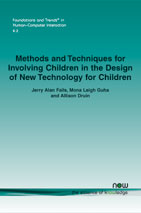Methods and Techniques for Involving Children in the Design of New Technology for Children
By Jerry Alan Fails, Montclair State University, USA, jerry.fails@montclair.edu | Mona Leigh Guha, University of Maryland, USA, mona@cs.umd.edu | Allison Druin, University of Maryland, USA, allisond@umiacs.umd.edu
Abstract
Children have participated in the design of technologies intended to be used by children with varying degrees of involvement, using diverse methods, and in differing contexts. This participation can be characterized as involving children as users, testers, informants, or design partners. It is only relatively recent that researchers around the world have begun to work more substantively with children to design technologies for children. This monograph synthesizes prior work involving children as informants and design partners, and describes the emergence of participatory design methods and techniques for children. We consider the various roles children have played in the design process, with a focus on those that integrally involve children throughout the process. We summarize and provide a pragmatic foundation for fellow researchers and practitioners to use several methods and techniques for designing technologies with and for children. In this monograph we relate the techniques to the design goals they help fulfill. The monograph concludes with a consideration of working with children in technology design processes as we move into the twenty-first century.
Methods and Techniques for Involving Children in the Design of New Technology for Children
Children have participated in the design of new technologies intended for children using diverse methods, in differing contexts, with varying degrees of involvement. This participation can be characterized as involving children as users, testers, informants, or design partners. Only relatively recently have researchers around the world begun to work more substantively with children to design technologies for children.
Methods and Techniques for Involving Children in the Design of New Technology for Children synthesizes prior work involving children as informants and design partners, and describes the emergence of participatory design methods and techniques for children. It considers the various roles children have played in the design process, with a focus on those that integrally involve children throughout the process. It summarizes and provides a pragmatic foundation for researchers and practitioners to use several methods and techniques for designing technologies with and for children. It relates the techniques to the design goals they help fulfil and concludes with a consideration of working with children in technology design processes as we move into the future.
